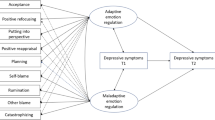Abstract
The present study examined the connection between contingency-competence-control–related beliefs, on the one hand, and anxiety and depression, on the other hand, in a large sample of young adolescents aged 10 to 14 years (N = 214). Participants completed measures of perceived contingency, competence, and control, as well as a questionnaire assessing symptoms of common anxiety disorders and major depressive disorder. Results showed that contingency-competence-control–related beliefs were intercorrelated and that these beliefs, in turn, were significantly associated with symptoms of anxiety and depression. Structural equation modeling provided support for a model in which perceived contingency and perceived competence predicted perceived control and in which perceived competence (anxiety and depression) and perceived control (depression only), in turn, predicted symptoms of psychopathology. A prospective test of this model indicated that none of the contingency-competence-control–related beliefs was able to predict symptoms of anxiety and depression at 4-weeks follow-up. However, data also demonstrated that perceived competence significantly contributed to the subjective experience of anxiety and depression on both occasions.
Similar content being viewed by others
References
Robinson NS, Garber J, Hilsman R: Cognitions and stress: Direct and moderating effects on depressive versus externalizing symptoms during junior high school transition. J Abn Psychol104:453–463, 1995.
Cole DA, Peeke L, Dolezal S, Murray N, Canzoniero A: A longitudinal study of negative affect and self-perceived competence in young adolescents. J Pers Soc Psychol77:851–862, 1999.
Stark KD, Schmidt KL, Joiner TE: Cognitive triad: Relationship to depressive symptoms, parents' cognitive triad, perceived parental messages. J Abn Child Psychol24:615–631, 1996.
Bandura A, Pastorelli C, Barbaranelli C, Caprara GV: Self-efficacy pathways to childhood depression. J Pers Soc Psychol 76:258–269, 1999.
Gladstone TRG, Kaslow NJ, Seeley JR, Lewinsohn PM: Sex differences, attributional style, and depressive symptoms among adolescents. J Abn Child Psychol 25: 297–305, 1997.
Kazdin AE, Esveldt-Dawson K, Sherick RB, Colbus D: Assessment of overt behavior and childhood depression among psychiatrically disturbed children. J Consult Clin Psychol 53:201–210, 1985.
Weisz JR, Stipek DJ: Competence, contingency, and the development of perceived control. Hum Dev 25:250–281, 1982.
Weisz JR: Understanding the developing understanding of control. In Cognitive perspectives on children's social and behavioral development: The Minnesota Symposia on Child Psychology (Vol. 18, pp. 219–285), ed. Perlmutter M. Hillsdale, NJ: Erlbaum, 1986.
Weisz JR, Weiss B, Wasserman AA, Rintoul B: Control-related beliefs and depression among clinic-referred children and adolescents. J Abn Psychol 96:58–63, 1987.
Weisz JR, Stevens JS, Curry JF, Cohen R, Craighead WE, Burlingame WV, Smith A, Weiss B, Parmelee DX: Control-related cognitions and depression among inpatient children and adolescents. J Am Acad Child Adolesc Psychiatry 28:358–363, 1989.
Weisz JR, Sweeney L, Proffitt VD, Carr T: Control-related beliefs and self-reported depressive symptoms in late childhood. J Abn Psychol 102:411–418, 1993.
Weisz JR, Southam-Gerow MA, McCarty CA: Control-related beliefs and depressive symptoms in clinic-referred children and adolescents: Developmental differences and model specificity. J Abn Psychol 110:97–109, 2001.
Chorpita BF: Control and the development of negative emotion. In The developmental psychopathology of anxiety (pp.112–142), eds. Vasey MW, Dadds MR. New York: Oxford University Press, 2001.
Chorpita BF, Barlow DH: The development of anxiety: The role of control in the early environment. Psychol Bull 124:3–21, 1998.
Chorpita BF, Brown TA, Barlow DH. Perceived control as a mediator of family environment in etiological models of childhood anxiety. Behav Ther 29:457–476, 1998.
Chorpita BF, Yim L, Moffitt C, Umemoto LA, Francis SE: Assessment of symptoms of DSM-IV anxiety and depression in children: A revised child anxiety and depression scale. Behav Res Ther 38:835–855, 2000.
American Psychiatric Association (APA): Diagnostic and Statistical Manual of Mental Disorders, fourth edition. Washington: American Psychiatric Association, 1994.
Weisz JR, Sweeney L, Proffitt VD: The Perceived Contingency Scale for Children. Los Angeles: Univerisity of California, 1991.
Harter S: Manual for the Self-Perception Profile for Children. Denver: University of Denver, 1985.
Weisz JR, Southam-Gerow MA, Sweeney L: The Perceived Control Scale for Children. Los Angeles: University of California, 1998.
Spence SH: A measure of anxiety symptoms among children. Behav Res Ther 36: 545–566, 1998.
Jöreskog KG, Sörbom D: LISREL 8.30. Chicago: Scientific Software International, 1999.
Gerbing DW, Anderson JC: Monte Carlo evaluations of goodness-of-fit indices for structural equation models. In Testing structural equation models (pp.10–39), eds. Bollen KA, Long JS. New York: Wiley, 1993.
Muris P, Meesters C, Schouten E: A brief questionnaire of DSM-IV defined anxiety and depression symptoms among children. Clin Psychol Psychother 9:430–442, 2002.
Meng XL, Rosenthal R, Rubin DB: Comparing correlated correlation coefficients. Psychol Bull111:172–175, 1992.
Vasey MW, Dadds MR: An introduction to the developmental psychopathology of anxiety. In The developmental psychopathology of anxiety (pp.3–26), eds. Vasey MW, Dadds MR. New York: Oxford University Press, 2001.
Kendall PC: Treating anxiety disorders in children: Results of a randomized clinical trial. J Consult Clin Psychol 62:100–110, 1994.
Lewinsohn PM, Clarke GN, Hops H, Andrews J: Cognitive-behavioral group treatment of depression in adolescence. Behav Ther 21:385–401, 1990.
Stallings P, March JS (1995): Assessment. In Anxiety disorders in children and adolescents (pp.125–147), ed. March JS. New York: Guilford Press, 1995.
Kazdin AE, Kagan J: Models of dysfuntion in developmental psychopathology. Clin Psychol Scie Pract 1:35–52, 1994.
Author information
Authors and Affiliations
Rights and permissions
About this article
Cite this article
Muris, P., Schouten, E., Meesters, C. et al. Contingency-Competence-Control–Related Beliefs and Symptoms of Anxiety and Depression in a Young Adolescent Sample. Child Psychiatry Hum Dev 33, 325–339 (2003). https://doi.org/10.1023/A:1023040430308
Issue Date:
DOI: https://doi.org/10.1023/A:1023040430308




